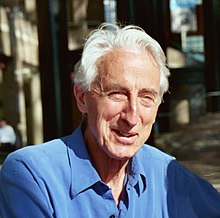Martin Gutzwiller
Martin Charles Gutzwiller (born October 12, 1925 in Basel ; † March 3, 2014 ) was a Swiss theoretical physicist .
Life
Gutzwiller was the son of Gisela (daughter of Paul Strassmann ) and Max Gutzwiller . He attended schools in Heidelberg , St. Gallen , Trogen and until 1944 in Friborg , where he also studied for a year before moving to the ETH in Zurich . With Wolfgang Pauli and Felix Villars he completed his diploma thesis on the magnetic moment of the nucleus in vector meson theory and completed his studies in 1950. Then he worked for Brown, Boveri & Cie. and went to Kansas State University , where he worked with Max Dresden in 1953PhD. His dissertation was entitled Quantum Theory of Wave Fields in Spaces of Constant Negative Curvature . Then he worked a. a. in the geophysical field for Shell and 1960 to 1963 for IBM in Switzerland and then in their "Thomas J. Watson Research Center" in Yorktown Heights, New York. In 1993 he retired there. He taught u. a. at Columbia University , the ETH, the University of Paris-Orsay and in Stockholm .
Since 1993 he has been the Adjunct Professor of Physics at Yale University .
Gutzwiller was a member of the US National Academy of Sciences and Fellow of the American Physical Society since 1992 , and a member of the American Academy of Arts and Sciences since 1993 . In 1993 he received the Dannie Heineman Prize for Mathematical Physics and in 2003 the Max Planck Medal (especially for his work in solid-state theory), an honorary doctorate from the University of Lausanne in 1995 and from the University of Friborg in 2000 .
In 1963, independently of John Hubbard and Junjiro Kanamori, he introduced a simple model that describes interacting electrons in the crystal lattice. This was later called the Hubbard model . A variation approach of the many-body wave function of the electrons, which was particularly successful with transition metals, is known as the Gutzwiller approximation .
Gutzwiller is best known for his trace formula from 1971, with which the density of states of chaotic quantum mechanical systems in the semiclassical limit case can be obtained from a sum over the classical periodic orbits of the system.
Gutzwiller also dealt with celestial mechanics and continued at IBM the ephemeris calculations on the moon that Wallace John Eckert began.
literature
- Martin Gutzwiller: Chaos in Classical and Quantum Mechanics . Springer, Graduate Texts in Mathematics, 1990
- Martin Gutzwiller: From transition metals to the trace formula . In: Physics Journal . 2003, July / August issue, pp. 39–43 (speech on the occasion of the award of the Max Planck Medal)
- Martin Gutzwiller: Quantum chaos . Spectrum March 1992
- To Martin C. Gutzwiller on His Seventy-Fifth Birthday . In: Foundations of Physics . Volume 31, No. 1, January 2001, pp. 1-5, ISSN 0015-9018 (print) ISSN 1572-9516 (online)
Web links
- Frank Steiner: Quantum Chaos . 1994 (on Gutzwiller's trace formula)
- Page at the MPI in Dresden , u. a. with curriculum vitae
- Gutzwiller Quantum Chaos , Scholarpedia
- Biography at the APS
Remarks
- ^ Wolfgang Paul Strassmann : The Strassmanns. The fate of a German-Jewish family over two centuries . Frankfurt / New York: Campus, 2006, ISBN 3-593-38034-X
- ^ Effect of Correlation on the Ferromagnetism of Transition Metals . In: Physical Review Letters . Volume 10, 1963, pp. 159-162; compare: John Hubbard: Electron correlations in narrow energy bands . In: Proceedings of the Royal Society of London . Volume A276, 1963, pp. 238-257; and Junjiro Kanamori: Electron Correlation and Ferromagnetism of Transition Metals . In: Progress of Theoretical Physics . Volume 30, No. 3, 1963; Pp. 275-289
- ↑ Martin Gutzwiller: Periodic orbits and classical quantization condition . In: Journal of Mathematical Physics . Volume 12, 1971, p. 343
- ↑ z. B. Martin Gutzwiller: Moon-Earth-Sun- the oldest three body problem . In: Reviews of Modern Physics . Volume 70, 1998, pp. 589-639.
- ^ Martin C. Gutzwiller and Dieter S. Schmidt: The Motion of the Moon as Computed by the Method of Hill, Brown and Eckert . In: Astronomical Papers Prepared For The Use Of The American Ephemeris And Nautical Almanac . Volume 23, 1986
| personal data | |
|---|---|
| SURNAME | Gutzwiller, Martin |
| ALTERNATIVE NAMES | Gutzwiller, Martin Charles (full name) |
| BRIEF DESCRIPTION | Swiss theoretical physicist |
| DATE OF BIRTH | October 12, 1925 |
| PLACE OF BIRTH | Basel |
| DATE OF DEATH | March 3, 2014 |
